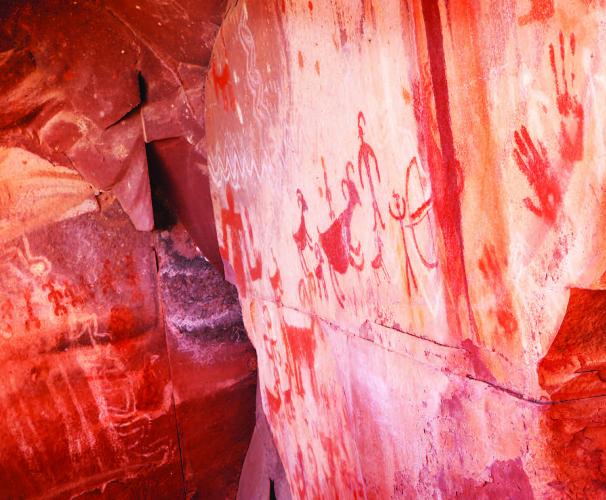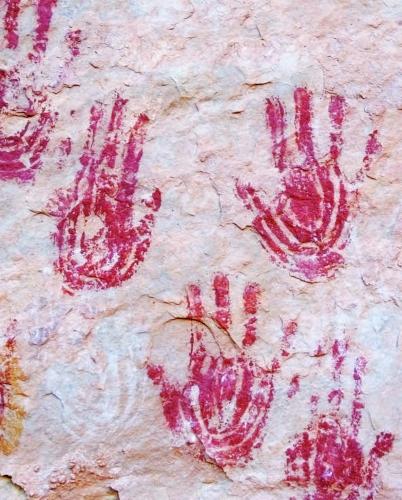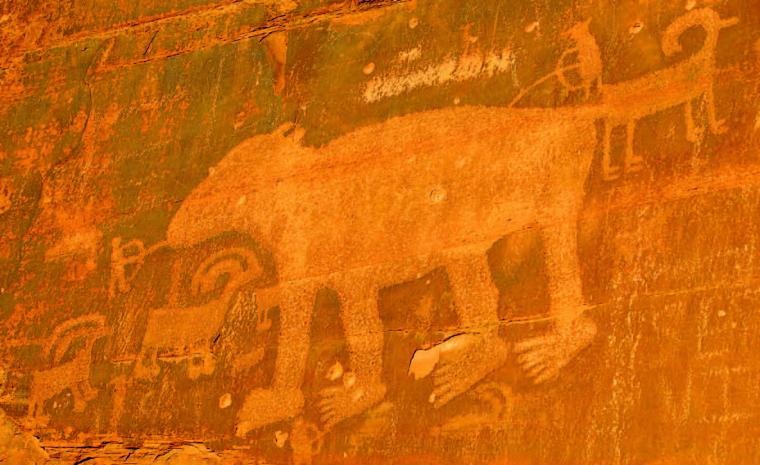Six million years ago, an ancestor, standing upright, began the human venture. This upright predecessor evolved near the equator, in Africa, followed by six million years of experiments in being human, as new species originated, diversified and became extinct.
From the outset, this venture took place in an era of instability and uncertainty. Although we used to think of East Africa as the nurturing “cradle of mankind,” it’s now understood to have created precarious tests of survival and adaptability. “The cauldron of human evolution” is a phrase I prefer, reflecting the roiling events and churning process that defined the thin line between thriving and decline, between survival and extinction in the era of human origins.
After several million years, the sole survivor of this radiation of bipedal species is Homo sapiens, worldwide in its extent: a turning point in the history of life due to our capacity to alter the world. Covering more than 50 percent of today’s land surface are human-dominated ecosystems, where energy flow is channeled largely toward human needs. When you add up the areas humans occupy, use or destroy, the total comes to some 83 percent of Earth’s viable land surface. Effects on the ocean and atmosphere add to this picture of our species’ pervasive impact.
The first two-thirds of our evolutionary history were exclusively in Africa. Around two million years ago, our genus, the genus Homo (which is African in origin), began to spread to new places, taking with it its ability to modify things. With the species Homo erectus, the ability to explore and disperse to new places enabled it to endure. In fact, Homo erectus survived nine times longer than our own species has been around so far, and from erectus we inherited a propensity to explore and colonize.
Yet much of what is distinctive of our species evolved later, over the past one million years:
- Attaining a particularly large brain relative to body size;
- Controlling fire and making shelters indicative of a central place on the landscape where the social group returned “home” in a way familiar to humans today;
- Prolonging the pace at which we grow up, with enormous implications for the time, care and energy we put into raising children – as well as for learning and the capacity for culture.
All of these were developments of the past one million years.
By 300,000 years ago, as documented by our recent excavations in the Kenya Rift Valley, we see the first obvious clues that a transition had occurred toward innovation.
- Tool kits that were new, including sharpened projectiles;
- Pigments that could be used for coloring, emblematic of an increasingly complex ability to use symbols and language;
- The development of social networks and the exchange of resources among groups living far apart;
- And, eventually, the diversifying of cultures, which multiplied the options of our species, diverse expressions of what it means to be human.
Dramatic Instability
These aspects of our heritage also arose in a dynamic, unpredictable world.
On a global scale, the past six million years have comprised one of the most dramatic periods of climate oscillation and environmental instability of the Cenozoic Era (covering the past 65 million years).
Every paleoclimate and paleoenvironmental record studied over the past 40 years has two signals – the overall trend and the amplitude of variability. Up until about 20 years ago, every student of human origins considered the variability as noise in the all-important trend toward a cooler, drier Earth: e.g., the development of savanna grasslands in Africa, and Ice Age conditions in northern latitudes. The direction of climate change – and the onset of a particular ancestral habitat – was thought to be the key signal that elicited the development of uniquely human adaptations.
Yet all of those many dozens of environmental records show evidence of dramatic instability between wet and arid, between cool and warm. As a result, variability and uncertainty have become the new theme in the environmental story of human origins.
The overarching narrative of human evolution has thus significantly changed. It has changed from a story of how the human lineage came to have dominion over its ancestral environment…to a story of evolving adaptability and persistent change in the challenges to survival.
There are many conclusions that can be drawn from these new perspectives on human origins. To summarize a few:
- During the era of human evolution, the natural world has had no enduring, stable baseline.
- Over the past several million years, high rates of extinction have occurred in most groups of vertebrates. This is true even in our own evolutionary group. Out of a minimum of 18 different species of evolutionary ancestors and cousins, only one lineage – our species – has survived. All the other ways of life of earlier hominins have gone extinct, even though each species possessed at least some of the unique distinguishing characteristics of human life.
- The difference between humans today and our extinct immediate relatives (in the evolutionary sense) is that our basic adaptations rely heavily upon an ability to alter the surroundings. This is our mode of survival.
Homo sapiens possesses, through its natural evolutionary heritage, an extraordinary capacity to modify landscapes; the distribution of food, water and other resources; and, most interesting, ourselves. We have an unprecedented proclivity to alter our ways of life, our systems of belief, and our transactions with one another and the world around us. This is responsible for the vast diversity of human behavior and our species’ cultural diversity.
From the standpoint of human origins, the starting point in thinking about the Anthropocene is that we live in the world by altering it. This is a function of our basic adaptations enabling us to buffer uncertainty and instability by changing how the world is.
Even simple interactions with the surroundings – making of a two million-year-old tool or a stone handaxe, moving resources across the landscape, creating fire, building a shelter, tending a plant to secure food – all of these basic elements of survival ended up changing the immediate surroundings.
This way of life became so successful that it spread worldwide.
The Age of Humans
Now we find ourselves where the planetary scale of human impact is unquestionable. Hence the idea of the Anthropocene, the Era of Humans.
Decreased biodiversity, revised biogeochemical cycles and novel combinations of climatic and ecological conditions arise from the existence of people everywhere. Of many impressive statistics, one of the more remarkable is that about six times more water is controlled by dams or in man-made lakes than occurs as free-flowing water on the continents. Regarding the atmosphere, despite differences in opinion over the exact future of rising CO2, what seems to get lost in the noise of manufactured debate is that even the most conservative estimates of sea-level rise would eventually inundate areas occupied by approximately 10 percent of the human population. Given the sharp rise in population during our lifetimes, the implications of 700–900 million people displaced, or requiring new livelihoods, have hardly been imagined.
For these reasons, the Anthropocene concept has largely gained traction by drawing attention to the harm we cause. There is justifiable hand-wringing over the unintended consequences of human activity – the “downstream effects” of human decisions, waste and emissions, the self-interest in the use of land and resources that underpin livelihoods and personal security and comforts.
Taking a different approach, I have begun to imagine what it would be like to have a different starting point in discussing this Age of Humans – one where we envision intended and purposeful consequences. What will it take to shape a world that is positive, meaningful, beneficial to life, in general, and to human welfare?
I’ve come to see the Anthropocene, therefore, not as debate about a new geological era but rather as a way of thinking – a way of thinking about our identity, and what it will mean to be human in the future. And so, our “thought experiment” here focuses less on specific problems, less on piecemeal solutions to the harm people may induce, and more on the principles that may guide meaningful pathways as we continue to alter the world and ourselves.
Embedded in Nature
Critical to imagining life in the Anthropocene is the importance of narrative in continually reshaping ourselves. Our evolutionary history is important in this regard. The ongoing revision of that narrative shows that we – and our altering tendencies – are embedded in a very dynamic natural world and fully interconnected with it. Revising the entwined human-and-nature narrative to reflect this point is, I believe, essential in how we will shape the future.
Cultural diversity, in itself, and as a reservoir of human knowledge and ways of life, is important. This diversity represents the expanded options of human behavior, our adaptations to the surroundings and our resilience as a species. Thus, from an evolutionary perspective, maintaining our cultural options is of enormous value.
At the same time, it is also valuable to embed our heterogeneity in an ethic and narrative of common purpose – a narrative of “one humanity” expressed locally in diverse ways. There is much to appreciate in a single origin that nurtures human identity as a species. The effect of a planetary, one-humanity narrative is to foster a sense of collective identity, the value of collective well-being, and a sense of shared responsibility for that well-being.
The positive paths we create in this Age of Humans will not be reached by a total consensus (that would not be “human” of us at all!). Yet in seeking meaningful futures, people must feel included in the community, national and global conversations. Inclusion can enable people to listen, reflect and act coherently even if actions are an expression of our inherent diversity.
We need to get over our mourning for an ancient concept of nature as pristine, eternal if only people would leave it alone. This idea defines nature as something that exists beyond where people live, and thus is now largely invisible, inaccessible and irrelevant to most people. Such an unchanging, original natural world is a misreading of nature. And it draws from the mistaken assumption that humans are separate from it by special dominion and mastery of the environment. This old myth offers none of the insights and understandings on which human lives depend as part of physical and biotic systems across the planet.
One of the most important principles to consider is resilience, or adaptability – a dynamic process. It means the capacity to adjust by processes of change and evolution. It is critical, however, to distinguish resilience from sustainability, another Anthropocene concept. In defining what we want the world to be, I think we all seek to sustain “the world that’s familiar to us” – the world as we see it. Yet an intended future will need to be defined in far more dynamic, ever-changing terms. Each decade will comprise a newly altered world. Understandings and hopes will need to be framed in ways we cannot begin to see. Every new generation will live in a new Anthropocene.
Certain definitions of sustainability are simply too static, seeking to stabilize what already exists, and to preserve the status quo, although it is unclear whose status quo should be preserved. World climate and other nonhuman systems are unpredictable enough. And human activities will continue to add new unpredictable effects. The combination will challenge our adaptability. This is one of the deep-time principles of human origins, and it is likely to continue as a principle of human origins. It seems wise not to anticipate a future that’s any different at least in this regard.
One of the realities of the Anthropocene is that human decisions about the surroundings are largely based on people’s satisfaction – satisfaction with green spaces, parks and conservancies created by and for people, or places of solitude that pay no heed to biodiversity baselines. Whether one judges this in terms of our own experiences as bad or good, human management and construction of nature is a reality of the Anthropocene.
We can certainly agree that every person has some stake in the health, abundance and transformations of the world around us. Planning for purposeful, beneficial outcomes will need to be in touch with the realities of human alteration of the environment, mismanagement, species loss and the miseries inherent in the range of human impulses and conflicts. And so, when it comes to building principles for living in the Anthropocene, there is certainly a need for people to become morally aroused and activated, with a deep sense of personal responsibility that will stretch us beyond self-interest.
In this light, I can suggest certain qualities that will contribute to a moral stance in the Anthropocene: Universality, inclusion, empathy, reciprocity, humility, connection to something larger than ourselves, our embeddedness in nature, a union of anthropocentric and biocentric thinking, which combines reasoning beneficial to both the human and nonhuman realms. Inclusion is the right of people to participate in a decision, which is linked to justice. Humility is the opposite of a certain sense of the word “dominion.” Embeddedness in nature is seeing ourselves as evolved as part of the natural world rather than separated from it. Empathy and reciprocity arise from taking the perspective of others.
There are more qualities that could be noted, and a conversation about each would require a lot of discussion. Yet I am convinced such qualities must become part of the shared social project of our new era.
This article is excerpted from a talk in the Anthropocene program of the Smithsonian Castle Lecture Series delivered on September 25, 2013



